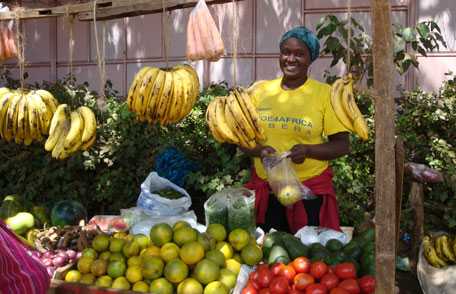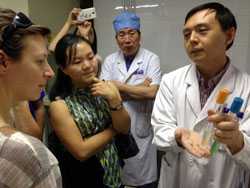Global Networks Make Food Safer
 Foodborne diseases are preventable, yet they commonly cause illness, disability, and death worldwide. Find out how CDC and global partners are providing countries with tools and training to make food safer to eat.
Foodborne diseases are preventable, yet they commonly cause illness, disability, and death worldwide. Find out how CDC and global partners are providing countries with tools and training to make food safer to eat.
Think locally, act globally
Food is essential. It provides nutrition and sustains life. We all deserve healthy, safe food, yet many countries lack basic public health resources to identify, track, and stop the spread of foodborne illnesses.
Once food becomes contaminated, germs and infection can spread rapidly through families, even between continents. Acting globally means sharing solutions and resources throughout the world to make food safer for everyone.

Food touches countless people before it reaches you.
Getting food to the table is a complex process. Food goes through many stages, and many people touch it before it reaches you. A single recipe may contain ingredients from many different countries. Food safety is a shared responsibility between producers, industry, governments, and consumers.
Working together to prevent foodborne disease
The Global Health Unit within CDC’s Division of Foodborne, Waterborne, and Environmental Diseases coordinates international activities to reduce diarrheal diseases, many of which are foodborne. The unit strives to help countries strengthen their ability to prevent, detect, and control these diseases.
Finding the sources of foodborne diseases requires epidemiologists, laboratory scientists, and veterinarians to regularly communicate with each other and share findings.
For the past 15 years, their Global Acute Diarrheal Diseases (GADD) program has helped countries such as China build capacity to investigate foodborne disease outbreaks and set up surveillance for germs that cause foodborne diseases. The program trains public health workers in other countries how to conduct investigations and develop surveillance for foodborne disease outbreaks.

CDC scientists work with Chinese food safety partners in the lab.
China: Food safety starts in the laboratory and connects in the field
CDC laboratory scientists in Atlanta and in China’s Global Disease Detection Center are working with the Chinese Ministry of Health, PulseNet China (a member of PulseNet International), and other partners to adapt U.S. best practices in foodborne disease detection and response for China. The laboratory scientists are detecting disease-causing germs that can be identified by DNA fingerprints, which are used to determine whether two sick people, regardless of where they live, were infected with the same germ.
This collaboration means Chinese microbiologists and epidemiologists now have laboratory tools and methods to detect foodborne disease. Eight provinces can receive specimens in their laboratories and identify common and new foodborne diseases. Three of these provinces are also developing advanced approaches to better detect foodborne diseases. Disease scientists can narrow their search for the tainted food and protect people from getting sick. The impact is clear: better lab detection yields more data and better discovery of cases and clusters. This training is now a model for other sites in China. Strengthening laboratory skills is an essential step that makes food safer—whether consumed in China, exported to the United States, or shipped worldwide.

WHO “Five keys to safer food” poster. Available in 82 languages on WHO site.
What about consumers?
Foodborne diseases can happen anywhere foods are improperly prepared or mishandled—including homes, restaurants, or street vendors.
Today, there are more food choices than ever before. Consumers face many complex options. What foods do I choose? How do I cook and store foods? And, how do I keep cooking areas clean? They may also lack knowledge about which foods, ingredients, and practices pose the greatest risk for foodborne disease.
Keys to Safer Food
Consumers play a key role in protecting themselves. WHO recommends that consumers should always follow safe food-handling guidelines:
- Keep food clean.
- Separate raw and cooked foods.
- Cook food thoroughly.
- Keep food at safe temperatures.
- Use safe water and raw materials.
- Page last reviewed: October 5, 2016
- Page last updated: October 5, 2016
- Content source:
- National Center for Emerging and Zoonotic Infectious Diseases
- Page maintained by: Office of the Associate Director for Communication, Digital Media Branch, Division of Public Affairs




 ShareCompartir
ShareCompartir